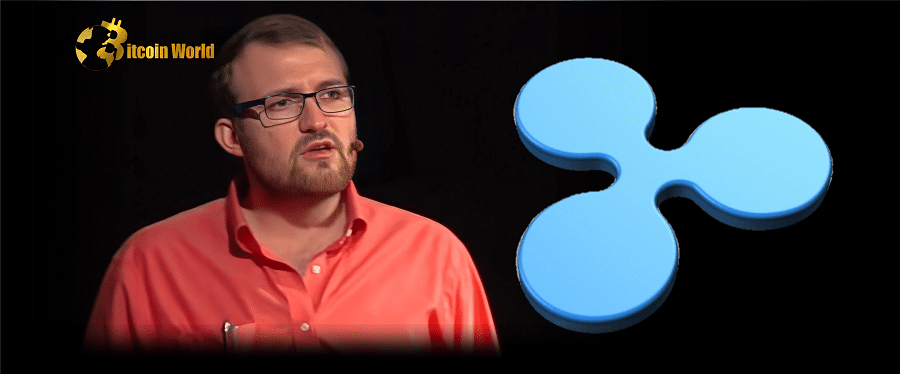The crypto world is never short of drama, and the ongoing saga between Cardano founder Charles Hoskinson and the Ripple (XRP) community is a prime example. Just when you thought things might be cooling down, new sparks have ignited, raising questions about the impact of this feud on XRP’s journey. Let’s dive into the latest developments and analyze what’s really going on.
The Twitter Spat: What Sparked the Latest Hoskinson-XRP Drama?
It all unfolded on December 17th when Charles Hoskinson took to Twitter, describing the XRP community as “toxic” and expressing his desire to distance himself from the project. This wasn’t a random outburst. It was a response to allegations stemming from December 16th, accusing the Cardano CEO of avoiding Bitcoin conferences due to perceived “insults” from some Bitcoin holders. Known for his outspoken nature, Hoskinson didn’t let these accusations slide, firing back and reigniting the long-standing tensions with the XRP faithful.
But Hoskinson clarified that his issues with Ripple weren’t solely about community toxicity. He went deeper, questioning the very essence of XRP’s contribution to the crypto space.
More Than Just Toxicity? Hoskinson’s Technical Critique of XRP
Hoskinson didn’t hold back in his critique, asserting that XRP offers no real technical value to Cardano or the broader cryptocurrency ecosystem. This is a significant statement coming from a prominent figure in blockchain development. Adding fuel to the fire, the Input Output co-founder recently agreed with the sentiment that an XRP settlement with the SEC could potentially lead to a price crash. These comments sparked a flurry of reactions, revealing a spectrum of opinions within both the ADA and XRP communities.
Community Divided: Does Ripple Need Hoskinson’s Approval?
The responses to Hoskinson’s statements were varied and revealing. Some XRP supporters believe that Ripple would benefit from Hoskinson’s insights and input. They see his criticism as potentially valuable for growth and improvement. On the other hand, many ADA and XRP holders expressed frustration, viewing the ongoing conflict as unnecessary and unproductive. This division highlights the passionate and often polarized nature of crypto communities, where opinions on projects and personalities can run deep.
Ripple’s Development Surge: Ignoring the Noise?
Amidst the Twitter drama and community debates, it’s crucial to look at the objective metrics of Ripple’s project. Interestingly, development activity for XRP has been on an upward trend. Data from Santiment shows that XRP’s development activity reached a peak around December 9th and has continued to remain high, standing at 9.79 at the time of reporting.
This surge in development activity suggests significant work happening behind the scenes in Ripple’s private GitHub repositories. It indicates that developers are actively contributing to the project, regardless of the public controversies. However, it’s important to note that, at least in the short term, this increased development activity hasn’t translated directly into positive price movement for XRP. Similarly, negative comments from figures like Hoskinson haven’t appeared to derail network upgrades or development progress.
Network Health Check: Beyond the Hoskinson Headlines
Let’s delve deeper into XRP’s network health beyond just development activity:
- Investor Accumulation: Investor activity, as indicated by the accumulation of XRP in custodial wallets, has remained relatively stable. The supply of XRP on exchanges has held steady at around 99.97 billion. This suggests a lack of significant selling pressure, but also no major influx of new investment into custodial holdings.
- Network Expansion Slowdown: Santiment data points to a noticeable slowdown in network expansion. XRP’s network growth was recorded at 1045, reflecting a decrease in user adoption and overall traction. Interestingly, this decline predates Hoskinson’s recent comments, suggesting that other factors might be at play.
- Seven-Day Circulation: On a slightly positive note, the seven-day circulation of XRP showed an attempt to recover from previous losses. While still modest, a decrease from 6.9 billion to 1.76 billion indicates fewer XRP transactions happening within that timeframe. This could be interpreted in various ways, but in this context, it’s presented as potentially offsetting some negative trends.
The Verdict: Is the Hoskinson-XRP Feud Really Impacting Ripple?
Based on the available data, it appears that Charles Hoskinson’s remarks, while generating headlines and community discussions, haven’t directly caused a visible disruption to the XRP network itself. Development activity is up, and while network growth has slowed, this trend began before the latest Hoskinson controversy. Investor activity remains stable.
It’s important to remember that the crypto market is influenced by a multitude of factors, and attributing specific price movements or network changes solely to individual opinions is often an oversimplification. While community sentiment and public perception can play a role, fundamental factors like technology, adoption, regulatory landscape, and broader market trends are typically more impactful.
Conclusion: Crypto Personalities and Project Progress
The ongoing exchange between Charles Hoskinson and the XRP community highlights the passionate and sometimes volatile nature of the crypto space. While personal opinions and critiques are part of the open discourse within crypto, it’s crucial to separate the noise from the actual progress and development of projects. In the case of Ripple, despite the external drama, the project continues to see development activity, even as some network metrics show mixed signals. Whether this feud ultimately has a long-term impact remains to be seen, but for now, Ripple appears to be navigating the controversy and focusing on building.
Disclaimer: The information provided is not trading advice, Bitcoinworld.co.in holds no liability for any investments made based on the information provided on this page. We strongly recommend independent research and/or consultation with a qualified professional before making any investment decisions.


